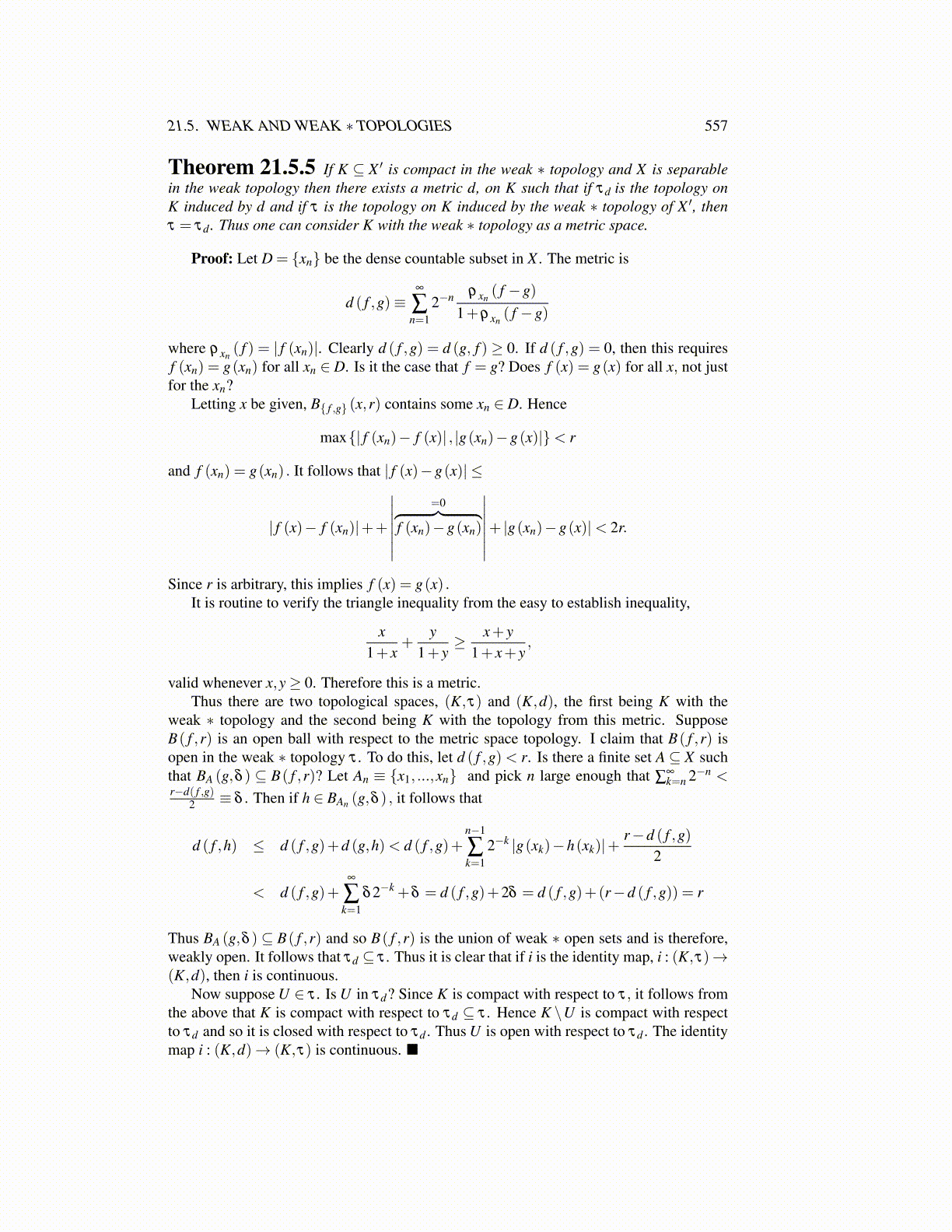
21.5. WEAK AND WEAK ∗ TOPOLOGIES 557
Theorem 21.5.5 If K ⊆ X ′ is compact in the weak ∗ topology and X is separablein the weak topology then there exists a metric d, on K such that if τd is the topology onK induced by d and if τ is the topology on K induced by the weak ∗ topology of X ′, thenτ = τd . Thus one can consider K with the weak ∗ topology as a metric space.
Proof: Let D = {xn} be the dense countable subset in X . The metric is
d ( f ,g)≡∞
∑n=1
2−n ρxn( f −g)
1+ρxn( f −g)
where ρxn( f ) = | f (xn)|. Clearly d ( f ,g) = d (g, f ) ≥ 0. If d ( f ,g) = 0, then this requires
f (xn) = g(xn) for all xn ∈ D. Is it the case that f = g? Does f (x) = g(x) for all x, not justfor the xn?
Letting x be given, B{ f ,g} (x,r) contains some xn ∈ D. Hence
max{| f (xn)− f (x)| , |g(xn)−g(x)|}< r
and f (xn) = g(xn) . It follows that | f (x)−g(x)| ≤
| f (x)− f (xn)|++
∣∣∣∣∣∣∣=0︷ ︸︸ ︷
f (xn)−g(xn)
∣∣∣∣∣∣∣+ |g(xn)−g(x)|< 2r.
Since r is arbitrary, this implies f (x) = g(x) .It is routine to verify the triangle inequality from the easy to establish inequality,
x1+ x
+y
1+ y≥ x+ y
1+ x+ y,
valid whenever x,y≥ 0. Therefore this is a metric.Thus there are two topological spaces, (K,τ) and (K,d), the first being K with the
weak ∗ topology and the second being K with the topology from this metric. SupposeB( f ,r) is an open ball with respect to the metric space topology. I claim that B( f ,r) isopen in the weak ∗ topology τ . To do this, let d ( f ,g)< r. Is there a finite set A⊆ X suchthat BA (g,δ ) ⊆ B( f ,r)? Let An ≡ {x1, ...,xn} and pick n large enough that ∑
∞k=n 2−n <
r−d( f ,g)2 ≡ δ . Then if h ∈ BAn (g,δ ) , it follows that
d ( f ,h) ≤ d ( f ,g)+d (g,h)< d ( f ,g)+n−1
∑k=1
2−k |g(xk)−h(xk)|+r−d ( f ,g)
2
< d ( f ,g)+∞
∑k=1
δ2−k +δ = d ( f ,g)+2δ = d ( f ,g)+(r−d ( f ,g)) = r
Thus BA (g,δ ) ⊆ B( f ,r) and so B( f ,r) is the union of weak ∗ open sets and is therefore,weakly open. It follows that τd ⊆ τ . Thus it is clear that if i is the identity map, i : (K,τ)→(K,d), then i is continuous.
Now suppose U ∈ τ . Is U in τd? Since K is compact with respect to τ, it follows fromthe above that K is compact with respect to τd ⊆ τ . Hence K \U is compact with respectto τd and so it is closed with respect to τd . Thus U is open with respect to τd . The identitymap i : (K,d)→ (K,τ) is continuous. ■